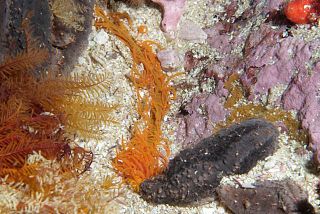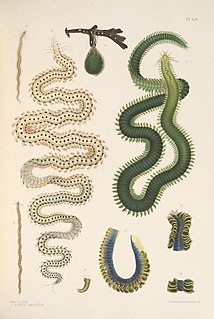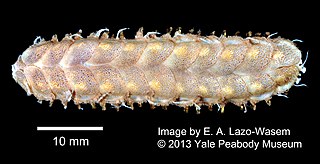Related Research Articles

Nereis is a genus of polychaete worms in the family Nereididae. It comprises many species, most of which are marine. Nereis possess setae and parapodia for locomotion. They may have two types of setae, which are found on the parapodia. Acicular setae provide support. Locomotor setae are for crawling, and are the bristles that are visible on the exterior of the Polychaeta. They are cylindrical in shape, found not only in sandy areas, and they are adapted to burrow. They often cling to seagrass (posidonia) or other grass on rocks and sometimes gather in large groups. They are dangerous to touch giving very painful long lasting burns. Nereis worms are commonly known as rag worms or clam worms. The body is long, slender, and dorso-ventrally flattened, reaching a length of 5-30 cm. The head consists of two parts: a roughly triangular anterior lobe—the prostomium—and a posterior ring-like portion—the peristomium. The latter bears a pair of terminal tentacles, dorsally two pairs of eyes, and ventrally a pair of short two-jointed palps.

Aphrodita is a genus of marine polychaete worms found in the Mediterranean sea and the eastern and western Atlantic Ocean.

The Terebellidae is a marine family of polychaete worms, of which the type taxon is Terebella, described by Carl Linnaeus in his 1767 12th edition of Systema Naturae.
Harmothoe is a genus of marine Polychaete worms belonging to the family Polynoidae. Species of Harmothoe are found world-wide to depths of at least 5,000 m but are more common in shallower water.
Acrocirridae is a family of polychaete worms. Acrocirrids are detritivores, catching falling particles with numerous long prostomial tentacles. There are eight known genera, and at least 21 described species and subspecies within the Acrocirridae. The acrocirrids are primarily benthic (seabed-dwelling) animals, but at least two genera appear to have evolved or adapted to a pelagic (free-swimming) habitat.

Phyllodoce is a genus of polychaete worms, which contains about 200 species. The prostomium bears eyes, two pairs of antennae and a pair of large retractile nuchal organs. The eversible proboscis is clearly divided into two parts.
Diopatra is a genus of polychaete worms in the family Onuphidae.

Amphinomidae, also known as the bristle worms or sea mice, are a family of marine polychaetes, many species of which bear chaetae mineralized with carbonate. The best-known amphinomids are the fireworms, which can cause great pain if their toxin-coated chaetae are touched or trodden on. Their relationship to other polychaete groups is somewhat poorly resolved.

The Euphrosinidae are a family of polychaete worms. The name is from Greek Euphrosyne, meaning merriment; she was one of the three Graces.

Cirriformia is a genus of marine polychaete worms in the family Cirratulidae.

Terebellides is a genus of polychaete worms in the family Trichobranchidae.

Eulalia is a genus of polychaete worms.

Lepidasthenia is a genus of marine Polychaete worms belonging to the family Polynoidae. Species of Lepidasthenia are found world-wide to depths of about 1200 m but are more common in shallower water.

Poecilochaetus is a genus of marine worms within the Polychaeta. It is the only genus in the monotypic family Poecilochaetidae. Members of this genus are benthic worms that burrow into soft sediments.

Eunoe is a genus of marine annelids in the family Polynoidae. The genus includes 48 species which are found world-wide, mostly from depths of 50 m or more.

Lepidonotus is a genus of marine annelids in the family Polynoidae. The genus occurs globally and includes 80 species, usually found in shallow waters down to about 80 metres.
Bathyeliasona is a genus of marine annelids in the family Polynoidae. The genus includes 4 abyssal and bathyal species which occur widely in the Atlantic, Pacific and Indian oceans, from depths of 2500 to 8000 m.
Bathyeliasona abyssicola is a deep-sea scale worm which occurs widely across the Pacific and Atlantic Oceans and over a wide depth range, from 4000m to 8000m.

Bathyeliasona nigra is a deep-sea scale worm which occurs widely in the Indian, Pacific and Atlantic Oceans from a depth range of about 2,500-5,000m.
References
- ↑ Singleton, Nathan (2010). Regional Estuary Monitoring Programme (REMP) Data Report: Benthic Macrofauna Communities and Sediments – July 2007 to April 2008 (Report). Waikato Regional Council. Retrieved 2021-02-18.
- ↑ "Aglaophamus". World Register of Marine Species]. Retrieved 2021-02-26.